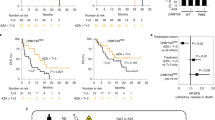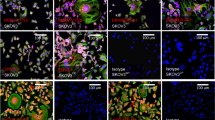Abstract
we describe the functional analysis of a novel retroviral vector, sf91m3, which was designed for improved expression of the in vivo selectable marker, multidrug resistance 1 gene (mdr1), in hematopoietic cells. sf91m3 combines several promising features. the vector backbone lacks viral coding sequences and aug-start codons 5′ of the mdr1 cdna. a point mutation of a cryptic splice acceptor of the mdr1 cdna increases the probability of transferring an intact provirus. the titer of a pg13 packaging cell clone containing a single proviral integration is high (>2 × 106 particles/ml from frozen stocks of serum-free vector harvests). human hematopoietic cells transduced with sf91m3 reliably express mdr1 before and after passage through nod/scid mice, as shown by quantitative pcr and efflux assays with rhodamine 123 or hoechst 33342. finally, sf91m3 mediates resistance to escalated doses of cytotoxic agents, as shown by survival and differentiation of transduced colony-forming cells in the presence of colchicine at 48 ng/ml (>10 × IC50). Thus, SF91m3 may represent an interesting candidate for future trials addressing the safety and utility of MDR1 gene transfer; moreover, this study demonstrates that sequence alterations improving post-transcriptional processing of retroviral vectors have a substantial impact for gene expression in hematopoietic cells.
This is a preview of subscription content, access via your institution
Access options
Subscribe to this journal
Receive 12 print issues and online access
$259.00 per year
only $21.58 per issue
Buy this article
- Purchase on Springer Link
- Instant access to full article PDF
Prices may be subject to local taxes which are calculated during checkout







Similar content being viewed by others
References
Williams DA, Hsieh K, DeSilva A, Mulligan RC . Protection of bone marrow transplant recipients from lethal doses of methotrexate by the generation of methotrexate-resistant bone marrow J Exp Med 1987 166: 210–218
Sorrentino BP et al. Selection of drug-resistant bone marrow cells in vivo after retroviral transfer of human MDR1 Science 1992 257: 99–103
Podda S et al. Transfer and expression of the human multiple drug resistance gene into live mice Proc Natl Acad Sci USA 1992 89: 9676–9680
Mickisch GH et al. Chemotherapy and chemosensitization of transgenic mice which express the human multidrug resistance gene in bone marrow: efficacy, potency, and toxicity Cancer Res 1991 51: 5417–5424
Devereux S et al. Feasibility of multidrug resistance (MDR-1) gene transfer in patients undergoing high-dose therapy and peripheral blood stem cell transplantation for lymphoma Gene Therapy 1997 5: 403–408
Rahman Z et al. Chemotherapy immediately following autologous stem-cell transplantation in patients with advanced breast cancer Clin Cancer Res 1998 4: 2717–2721
Hesdorffer C et al. Phase I trial of retroviral-mediated transfer of the human MDR1 gene as marrow chemoprotection in patients undergoing high-dose chemotherapy and autologous stem-cell transplantation J Clin Oncol 1998 16: 165–172
Cowan KH et al. Paclitaxel chemotherapy after autologous stem-cell transplantation and engraftment of hematopoietic cells transduced with a retrovirus containing the multidrug resistance complementary DNA (MDR1) in metastatic breast cancer patients Clin Cancer Res 1999 5: 1619–1628
Moscow JA et al. Engraftment of MDR1 and NeoR gene-transduced hematopoietic cells after breast cancer chemotherapy Blood 1999 94: 52–61
Abonour R et al. Efficient retrovirus-mediated transfer of the multidrug resistance 1 gene into autologous human long-term repopulating hematopoietic stem cells Nature Med 2000 6: 652–658
Eckert HG et al. High-dose multidrug resistance in primary human hematopoietic progenitor cells transduced with optimized retroviral vectors Blood 1996 88: 3407–3415
Kim M, Cooper DD, Hayes SF, Spangrude GJ . Rhodamine-123 staining in hematopoietic stem cells of young mice indicates mitochondrial activation rather than dye efflux Blood 1998 91: 4106–4117
Sorrentino BP, McDonagh KT, Woods D, Orlic D . Expression of retroviral vectors containing the human multidrug resistance 1 cDNA in hematopoietic cells of transplanted mice Blood 1995 86: 491–501
Hildinger M et al. Dominant selection of hematopoietic progenitor cells with retroviral MDR1-coexpression vectors Hum Gene Ther 1998 9: 33–42
Galipeau J et al. A bicistronic retroviral vector for protecting hematopoietic cells against antifolates and P-glycoprotein effluxed drugs Hum Gene Ther 1997 8: 1773–1783
Zaboikin MM, Schuening FG . Poor expression of MDR1 transgene in HeLa cells by bicistronic Moloney murine leukemia virus-based vector Hum Gene Ther 1998 9: 2263–2275
Bunting KD et al. Transduction of murine bone marrow cells with an MDR1 vector enables ex vivo stem cell expansion, but these expanded grafts cause a myeloproliferative syndrome in transplanted mice Blood 1998 92: 2269–2279
Baum C et al. Novel retroviral vectors for efficient expression of the multidrug resistance (mdr-1) gene in early hematopoietic cells J Virol 1995 69: 7541–7547
Grez M, Akgun E, Hilberg F, Ostertag W . Embryonic stem cell virus, a recombinant murine retrovirus with expression in embryonic stem cells Proc Natl Acad Sci USA 1990 87: 9202–9206
Hildinger M et al. Design of 5′ untranslated sequences in retroviral vectors developed for medical use J Virol 1999 73: 4083–4089
Hildinger M et al. Bicistronic retroviral vectors for combining myeloprotection with cell surface marking Gene Therapy 1999 6: 1222–1230
Eckert HG et al. Clinical scale production of an improved retroviral vector expressing the human multidrug resistance 1 gene (MDR1) Bone Marrow Transplant 2000 25: S114–117
Miller AD et al. Construction and properties of retrovirus packaging cells based on gibbon ape leukemia virus J Virol 1991 65: 2220–2224
von Kalle C et al. Increased gene transfer into human hematopoietic progenitor cells by extended in vitro exposure to a pseudotyped retroviral vector Blood 1994 84: 2890–2897
Schilz AJ et al. High efficiency gene transfer to human hematopoietic SCID-repopulating cells under serum-free conditions Blood 1998 92: 3163–3171
Kiem HP et al. Improved gene transfer into baboon marrow repopulating cells using recombinant human fibronectin fragment CH-296 in combination with interleukin-6, stem cell factor, FLT-3 ligand, and megakaryocyte growth and development factor Blood 1998 92: 1878–1886
van Hennik PB et al. Highly efficient transduction of the green fluorescent protein gene in human umbilical cord blood stem cells capable of cobblestone formation in long-term cultures and multilineage engraftment of immunodeficient mice Blood 1998 92: 4013–4022
Schiedlmeier B et al. Quantitative assessment of retroviral gene transfer of the human multidrug resistance-1 gene to human mobilized peripheral blood progenitor cells engrafting in NOD/SCID mice Blood 2000 95: 1237–1248
Goodell MA et al. Dye efflux studies suggest that hematopoietic stem cells expressing low or undetectable levels of CD34 antigen exist in multiple species Nature Med 1997 12: 1337–1345
Hildinger M . PhD thesis, University of Hamburg, 2000,http://www.sub.uni-hamburg.de/disse/78/disse.pdf
Jelinek J et al. A novel dual function retrovirus expressing multidrug resistance-1 and O6-alkylguanine-DNA-alkytransferase for engineering resistance of haemopoietic progenitor cells to multiple chemotherapeutic agents Gene Therapy 1999 6: 1489–1493
Sugimoto Y et al. Coexpression of a multidrug-resistance gene (MDR1) and herpes simplex virus thymidine kinase gene as part of a bicistronic messenger RNA in a retrovirus vector allows selective killing of MDR1-transduced cells Clin Cancer Res 1995 1: 447–457
Aran JM, Gottesman MM, Pastan I . Drug-selected coexpression of human glucocerebrosidase and P-glycoprotein using a bicistronic vector Proc Natl Acad Sci USA 1994 91: 3176–3180
Dunbar C et al. Transplantation of rhesus hematopoietic cells with an MDR1 vector does not result in ex vivo or in vivo expansion or a myeloproliferative syndrome. The Third Annual Meeting of the American Society of Gene Therapy, May 31–June 4, 2000, Denver, Coloradohttp://www.apnet.com/www/journal/asgt/7716.html
Acknowledgements
This work was supported by the Bundesministerium für Bildung und Forschung (01KV9811) and in part by grants 10-1294-Ze2 and 10-1456-Ba2 of the Deutsche Krebshilfe. The Heinrich-Pette-Institute is supported by the Freie und Hansestadt Hamburg and by the Bundesministerium für Gesundheit.
Author information
Authors and Affiliations
Rights and permissions
About this article
Cite this article
Knipper, R., Kuehlcke, K., Schiedlmeier, B. et al. Improved post-transcriptional processing of an MDR1 retrovirus elevates expression of multidrug resistance in primary human hematopoietic cells. Gene Ther 8, 239–246 (2001). https://doi.org/10.1038/sj.gt.3301384
Received:
Accepted:
Published:
Issue Date:
DOI: https://doi.org/10.1038/sj.gt.3301384
Keywords
This article is cited by
-
A novel gene transfer strategy that combines promoter and transgene activities for improved tumor cell inhibition
Cancer Gene Therapy (2005)
-
Hematopoietic stem cell gene therapy with drug resistance genes: an update
Cancer Gene Therapy (2005)
-
Resistance to cytarabine and gemcitabine and in vitro selection of transduced cells after retroviral expression of cytidine deaminase in human hematopoietic progenitor cells
Leukemia (2005)
-
Self-inactivating retroviral vectors with improved RNA processing
Gene Therapy (2004)
-
Impact of splice-site mutations of the human MDR1 cDNA on its stability and expression following retroviral gene transfer
Gene Therapy (2003)



